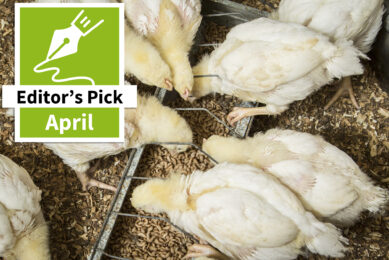Diamond V product benefits broiler breeder profitability
New poultry research results announced by Diamond V, at the International Poultry Expo, Atlanta, Georgia, spotlights technology that helps breeder producers improve their profitability by promoting egg production among broiler breeders, progeny performance, and processing yield.
Conducted by Auburn University, the research study utilized day-old Cobb 500 breeder pullets that were separated into different light-proof rooms. And their offspring was tested as well. The aim of the trials was to measure the effect of Original XPC in the feed.
The key bioactive components in Original XPC are a result of a proprietary anaerobic fermentation process that yields a biologically complex product that supports robust digestive health by balancing gut microbiota, the immune system and optimizing gut morphology.
Breeder trial setup
They were fed either a control diet or a diet containing Diamond V Original XPC. Cockerels were fed a control diet in a separate, fourth room. Birds were fed on a skip-a-day restricted feeding program.
At 19 weeks of age the birds were moved to the breeder facility with 10 replicate pens per treatment and 37 hens per pen.
At 22 weeks of age, four roosters were introduced per pen and fed the control feed.
At 34 weeks of age, eggs were collected and separated by hen treatment for progeny hatching in NatureForm 2000 incubator/hatching machines.
Breeder hen egg production data was collected through 43 weeks of age.
Broiler trial setup
From each of the hen groups, 189 progeny hatched. Twenty–one mixed-sex progeny were placed in nine replicate pens based on the breeder diet: control or Original XPC.
All progeny were fed the control feed and raised in litter floor pens.
At 14, 28, and 42 days of age, the progeny were weighed and fed, and feed conversion was calculated.
At 42 days of age, 10 birds per pen were removed and their live weights were recorded.
The birds were then processed at a pilot processing plant where carcass weights were measured. Carcasses were then cut up, the breast meat weighed, and yields calculated.
Breeder egg production was analyzed using repeated measures analysis. Progeny results were analyzed using ANOVA. Means were compared by contrasts: control versus treatment.
Results
Feeding Original XPC to broiler breeders promoted egg production with a positive change of 2.5 eggs produced during the 26-43 week period.
The maternal diet effected progeny. Breast meat yield was promoted by feeding Original XPC with a change of 7.4% in breast meat weight and a change of 0.69% in breast meat yield.
Carcass yield was promoted with a change of 4.8% in carcass weight and a change of 0.44% in carcass yield.
Progeny weight was promoted with progeny weighting approximately 2.9% more at day 14 and approximately 2.8% more at day 42.
Feed conversion, adjusted for mortality and common bodyweight, improved by approximately 2 points (1.7%) at day 14 and 3 points (1.6%) at day 42.
Join 26,000+ subscribers
Subscribe to our newsletter to stay updated about all the need-to-know content in the feed sector, three times a week. Beheer
Beheer









 WP Admin
WP Admin  Bewerk bericht
Bewerk bericht